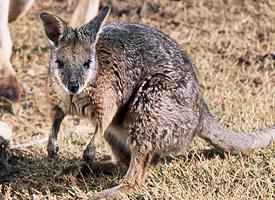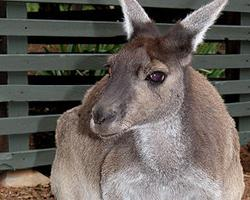
Greutăți și măsuri
| Lungime | de la 60 la 85 cm |
|---|---|
| Greutate | de la 9 la 27 kg |
Descrierea animalului
The Agile Wallaby (Notamacropus agilis), also known as the Sandy Wallaby, is a fascinating and adaptable marsupial native to northern Australia and New Guinea. This species belongs to the family Macropodidae, which includes kangaroos and other wallabies, and is recognized for its remarkable agility, as its name suggests.Characteristically smaller than a kangaroo, the Agile Wallaby has a robust and compact body with a length ranging from 60 to 85 centimeters (24 to 33 inches) for its head and body, while its tail can be almost as long, adding another 60 to 70 centimeters (24 to 28 inches). Males are generally larger and more muscular than females, weighing up to 27 kilograms (60 pounds), whereas females usually weigh around 15 kilograms (33 pounds).
The coat of the Agile Wallaby is predominantly a light brown or grey color, blending seamlessly with the surrounding environment, which provides excellent camouflage against predators. The underparts are usually lighter, ranging from white to a soft cream. One distinctive feature of this species is the dark stripe that runs from the middle of the head down to the back, accompanied by lighter stripes on the cheeks and the sides of the body.
Agile Wallabies are primarily herbivorous, feeding on a wide variety of grasses, leaves, and occasionally fruits and flowers. They have a flexible diet that allows them to adapt to different environments, from coastal areas and riverbanks to grasslands and forest edges. This adaptability in feeding habits ensures their survival in various habitats and conditions.
Socially, the Agile Wallaby exhibits interesting behaviors. They are generally solitary or live in small groups called mobs, which can sometimes include up to ten individuals. These groups are often loose associations, rather than tightly knit units, and are believed to be formed mainly for the benefits of predator awareness. Within these groups, there is a social hierarchy, especially among males, who compete for access to females, particularly during the breeding season.
Reproduction in Agile Wallabies is remarkable due to their ability to exhibit embryonic diapause, a condition where the development of the embryo can be paused during adverse conditions. Typically, breeding occurs throughout the year, with females giving birth to a single joey after a gestation period of about 30 days. The newborn is underdeveloped and crawls into its mother's pouch, where it continues to grow and develop over the next few months. Joeys usually leave the pouch around six to eight months of age but may continue to suckle until they are around 11 to 12 months old.
The Agile Wallaby is an excellent jumper, capable of making long leaps to escape predators and navigate its environment. This mobility is a key survival trait, allowing it to quickly cover ground and find food and water sources over large areas.
Despite facing threats from habitat loss, predation by introduced species, and occasional culling, the Agile Wallaby is currently listed as a species of least concern by the International Union for Conservation of Nature (IUCN). However, continued efforts in conservation and habitat protection are necessary to ensure the stability of their populations in the wild.
Animale similare
Fotografii noi cu animale
Top 10 animale
- Dolphin gull (Leucophaeus scoresbii)
- Diana monkey (Cercopithecus diana)
- Moustached guenon (Cercopithecus cephus)
- Galápagos tortoise (Geochelone nigra complex)
- Russian tortoise (Testudo horsfieldii)
- Stone loach (Barbatula barbatula)
- Japanese macaque (Macaca fuscata)
- Common flying dragon (Draco volans)
- Greek tortoise (Testudo graeca)
- Vendace (Coregonus albula)


